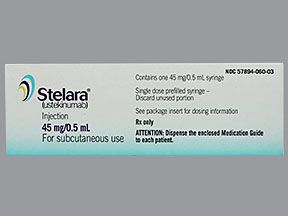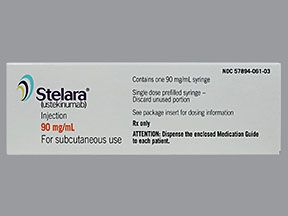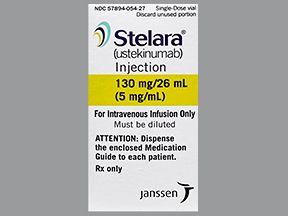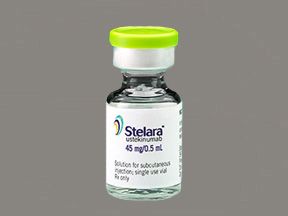Stelara (ustekinumab) is a brand-name prescription drug that treats ulcerative colitis, Crohn’s disease, plaque psoriasis, and psoriatic arthritis. Stelara comes as a solution that’s given as a subcutaneous injection or an IV infusion. The dosage can vary depending on several factors.
Stelara is approved by the Food and Drug Administration (FDA) for use in adults. It is also prescribed to certain children to treat plaque psoriasis and psoriatic arthritis.
Stelara is a monoclonal antibody, which is a
Keep reading for specific information about the dosage of Stelara, including its strengths and how to receive the medication. For a comprehensive look at Stelara, see this article.
Note: This article describes typical dosages for Stelara provided by the drug’s manufacturer. When using Stelara, always follow the dosage prescribed by your doctor.
If your doctor has prescribed Stelara, you may have questions about your dosage, such as what a typical injection dosage is or what a low Stelara dosage may be for your condition. Below are details about Stelara dosage by weight, how often to take Stelara, and other information about how the drug is used.
Stelara forms and strengths
Stelara comes as a liquid solution and contains the active drug ustekinumab. It’s available in the following forms and strengths:
- A single-dose prefilled syringe for subcutaneous injection that’s available in two different strengths: 45 milligrams (mg) per 0.5 milliliters (mL) and 90 mg/mL.
- A single-dose vial for subcutaneous injection that’s used with a syringe and needle to draw up a dose. This vial is available in one strength: 45 mg/0.5 mL.
- A single-dose vial for intravenous (IV) infusion, which is administered only by healthcare professionals. This vial is available in one strength: 5 mg/mL.
Typical dosages and schedules
Typically, your doctor will start you on a low dosage. Then they’ll adjust it over time to reach the amount that’s right for you. Your doctor will ultimately prescribe the smallest dosage that provides the desired effect.
The following information describes dosing schedules that are commonly used or recommended. However, be sure to use the dosage that your doctor prescribes for you. Your doctor will determine the best dosing schedule to fit your needs.
Dosage for psoriatic arthritis
For treating some forms of psoriatic arthritis, adults receive Stelara by subcutaneous injection. Your first dose will be a 45-mg injection. You’ll receive your second 45-mg dose 4 weeks later. Then you’ll have a 45-mg injection every 12 weeks.
If you weigh more than 100 kilograms (about 220 pounds) and also have plaque psoriasis, your doctor will typically prescribe a 90-mg dose. After your first dose, you’ll receive a 90-mg dose 4 weeks later. Then you’ll have a 90-mg dose every 12 weeks.
Dosage for ulcerative colitis or Crohn’s disease
Stelara is used to treat some forms of ulcerative colitis or Crohn’s disease in adults. For this purpose, the recommended maintenance dosage of Stelara is a 90-mg subcutaneous injection every 8 weeks. The maintenance dosage is the usual dosage you’ll have after your starting dose (see below).
Starting dose for UC or Crohn’s disease
For this purpose, adults first receive a starting dose of Stelara by IV infusion. A starting dose (also known as a loading dose) is used to get the medication working in your body quickly.
The Stelara starting doses by weight are below. (“Kg” stands for kilograms, and “lb” stands for pounds.)
| Body weight | Stelara dose |
| 55 kg (about 121 lb) or less | 260 mg |
| More than 55 kg to 85 kg (about 187 lb) | 390 mg |
| More than 85 kg | 520 mg |
Maintenance dose for UC or Crohn’s disease
For treating UC or Crohn’s disease, the recommended maintenance dosage of Stelara is a 90-mg subcutaneous injection given every 8 weeks, regardless of your weight. The maintenance dosage is the usual dosage you’ll receive after your starting dose.
Dosage for plaque psoriasis
For treating some forms of plaque psoriasis, adults receive Stelara by subcutaneous injection. The Stelara dosage by weight is as follows:
- If you weigh 100 kg (about 220 lb) or less. You’ll first receive a 45-mg dose. After 4 weeks, you’ll receive a second 45-mg dose. Then you’ll receive a 45-mg dose every 12 weeks.
- If you weigh more than 100 kg. You’ll first receive a 90-mg dose. After 4 weeks, you’ll receive a second 90-mg dose. Then you’ll receive a 90-mg dose every 12 weeks.
Long-term use
Stelara is meant to be used as a long-term treatment. If you and your doctor determine that Stelara is safe and effective for you, you’ll likely use it long term.
Children’s dosage
Stelara is approved to treat some forms of plaque psoriasis and psoriatic arthritis in certain children ages 6 years and older. For this purpose, Stelara is given by subcutaneous injection.
The recommended children’s dosage is based on body weight:
| Body weight | Recommended dose |
| Less than 60 kg (about 132 lb) | 0.75 mg per kg |
| 60 kg to 100 kg (about 220 lb) | 45 mg |
| More than 100 kg | 90 mg |
After your child receives their first dose, they’ll receive a second dose 4 weeks later. Then they’ll receive a dose every 12 weeks.
If you miss a dose of Stelara, talk with your doctor. They can help set up a new dosing schedule.
To help make sure that you don’t miss a dose, try using a medication reminder. This can include setting an alarm or timer on your phone or downloading a reminder app.
The Stelara dosage that your doctor prescribes will depend on several factors. These include:
- the condition or conditions you’re using Stelara to treat
- your weight
- your age
You should always use the Stelara dosage that your doctor prescribes for you.
Dosage adjustments
If you have both psoriatic arthritis and plaque psoriasis, your doctor will typically prescribe a higher Stelara dose than usual for you. For more information, see “Dosage for psoriatic arthritis” in the “Dosage for psoriatic arthritis” section above.
Be sure to use Stelara according to your doctor’s instructions.
Stelara is given by subcutaneous injection for most of the conditions that it’s approved to treat. Your healthcare professional will give you your first dose. They may also show you how to inject the medication yourself for future doses. The drug can be given under the skin of your abdomen (belly), thighs, buttocks, or upper arms.
If you’re using Stelara to treat ulcerative colitis or Crohn’s disease, you’ll receive your first dose as an intravenous (IV) infusion. This is an injection into a vein given over a period of time. A healthcare professional will give you the IV infusion at a clinic, doctor’s office, or infusion center. After your first dose, you’ll receive Stelara as subcutaneous injections.
To help you give yourself Stelara injections, the drug’s manufacturer has step-by-step instructions. It also provides instructional videos about how to self-inject Stelara.
It’s important that you don’t use more Stelara than your doctor prescribes. For some medications, taking more than the recommended amount may lead to side effects or overdose.
If you use more than the recommended amount of Stelara
Call your doctor right away if you believe you’ve used too much Stelara. Another option is to call America’s Poison Centers at 800-222-1222 or use its online tool. If you have severe symptoms, immediately call 911 or your local emergency number, or go to the nearest emergency room.
The dosages in this article are typical ones provided by the drug’s manufacturer. If your doctor recommends Stelara for you, they will prescribe the dosage that’s right for you. Always follow the dosage that your doctor prescribes for you.
As with any drug, never change your dosage of Stelara without your doctor’s approval. If you have questions about the dosage of Stelara that’s right for you, talk with your doctor.
Besides learning about the dosages, you may want other information about Stelara. These additional articles might be helpful to you:
- More about Stelara. For information about other aspects of Stelara, refer to this article.
- Side effects. To learn about side effects of Stelara, see this article. You can also look at the Stelara prescribing information.
- Cost. For information about Stelara’s cost, view this article.
- Drug comparison. To find out how Stelara compares with other drugs, read the comparison articles about Cosentyx, Humira, and Otezla.
- Details about your condition. For details about your condition, see our:
- dermatology and skin care hub and list of psoriasis articles
- arthritis hub and list of psoriatic arthritis articles
- list of Crohn’s articles and this article about Stelara for Crohn’s disease
- list of ulcerative colitis articles
Disclaimer: Medical News Today has made every effort to make certain that all information is factually correct, comprehensive, and up to date. However, this article should not be used as a substitute for the knowledge and expertise of a licensed healthcare professional. You should always consult your doctor or another healthcare professional before taking any medication. The drug information contained herein is subject to change and is not intended to cover all possible uses, directions, precautions, warnings, drug interactions, allergic reactions, or adverse effects. The absence of warnings or other information for a given drug does not indicate that the drug or drug combination is safe, effective, or appropriate for all patients or all specific uses.




